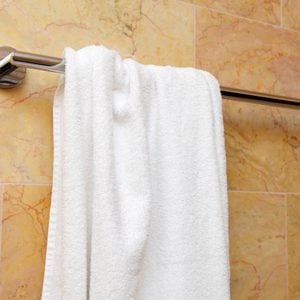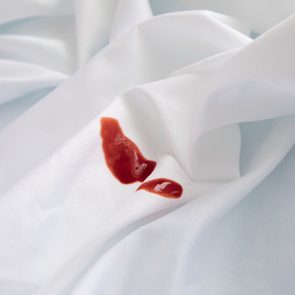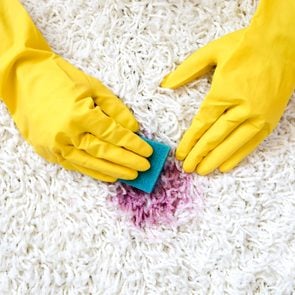How to Wash Pillows So They’re Completely Clean and Super Snuggly
Updated: Apr. 19, 2024
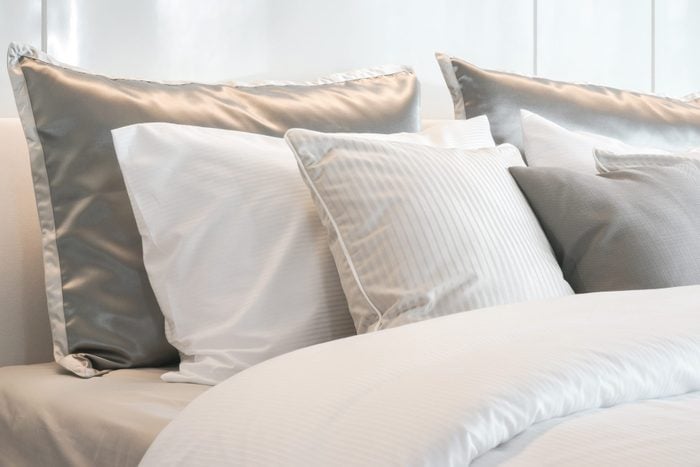
Yes, pillows need cleaning too. Here's how to wash pillows correctly, plus how often you should be doing it.
You wash your clothes after each wear and even manage to wash your sheets every week. But your pillows? When’s the last time you gave those a thorough run through the wash cycle? Knowing how to wash pillows, and doing so regularly, is vital hygienically. Pillows regularly come into contact with sweat, skin, oils, dust mites and other undesirables, and washing cuts down on potentially harmful bacteria and allergens that can build up and trigger allergies, asthma, breakouts and more. Plus, nothing beats putting your head down on a fresh, clean pillow.
But even if you know how to do laundry, there are some special considerations when it comes to washing pillows, including the material, size, just how dirty they are and which drying method makes the most sense.
To find out the best way to wash pillows (without making them lumpy), we consulted fabric and laundry experts Patric Richardson, host of The Laundry Guy on HGTV and Discovery+, and Kim Romine, fabric-care scientist with Procter & Gamble. Here are their pillow-washing step-by-step instructions to simplify the process.
Get Reader’s Digest’s Read Up newsletter for more cleaning, humor, travel, tech and fun facts all week long.
About the experts
Reviewed for accuracy by: Mary Marlowe Leverette, a highly regarded fabric-care, stain-removal and housekeeping expert with more than 40 years of experience. |
On This Page
Can you machine-wash pillows?
In general, most types of pillows are machine-washable and can be washed on a cool, gentle setting with vinegar, laundry soap or a mild detergent. This goes for pillows filled with cotton, polyester and even down and feathers. The exception: foam-filled pillows. These cannot be machine-washed (see below for specific instructions).
If your goal is to sanitize, you may choose to wash on the hottest temperature—studies have shown that water must be 140 degrees to kill dust mites. That said, it’s always important to first check your pillow’s care label to see if there are any specific cleaning instructions recommended. Pay special attention to the laundry symbols on the label, including the suggested wash temperature.
It’s best to use a front-loading washing machine, if you have access to one, says Romine. Some pillows can float in a top-loading washing machine, which can cause dry patches or areas that aren’t entirely clean. Her suggestion: If you have a top-loader, saturate your down pillows with water (which will weigh them down) before placing them inside the drum. You could also visit a laundromat to use a front-loading machine there.
Can you put pillows in the dryer?
Unless your pillow is made of foam, most pillows can be placed in the dryer on a low-heat setting. However, make sure to read the label on your pillow to check the specific instructions before adding pillows to your cleaning schedule.
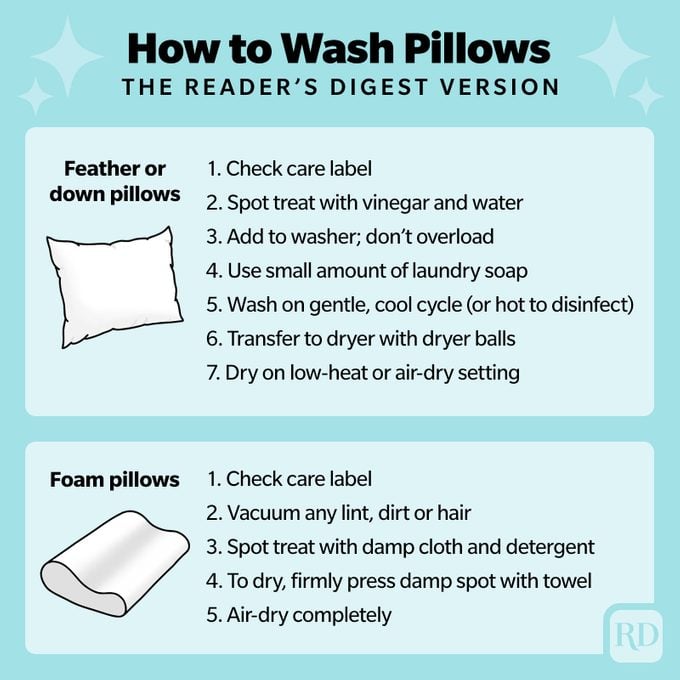
How to wash feather or down pillows
Of all the varieties of pillows, down pillows should be washed most often, says Richardson. Because the filling is loose, a lot of dirt and pathogens can penetrate down comforters and pillows. He compares it to dropping your keys in a ball pit; like the keys, dirt can work its way all the way to the bottom of the pillow.
Richardson chooses to wash down pillows with either vinegar or laundry soap. Harsh commercial detergents, he says, may leave a residue behind that can make down clump together.
Gentle detergents can be used to wash down, feather or polyester fiberfill pillows, says fabric-care expert Mary Marlowe Leverette. She recommends using the same gentle detergent you would use for washing a cashmere sweater. “Choose a gentle detergent that is low-sudsing (look for the HE symbol) for easier rinsing and contains no dyes or fragrances that can leave a residue, which causes clumping.” Leverette also suggests using only 1 to 2 teaspoons of the detergent (or one gentle laundry pod) per load of pillows. Overdosing requires additional rinse cycles to flush any residue, she advises. Here are the steps to clean down or feather pillows properly.
Supplies you’ll need
- White vinegar
- Water
- Toothbrush
- Stain remover (optional)
- Laundry soap or gentle laundry detergent
- Tennis or dryer balls
Step 1: Remove pillowcase
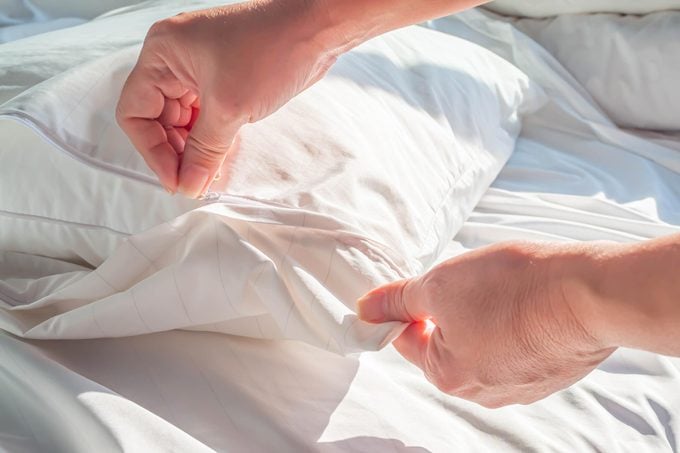
Remove the pillowcase and/or protector and clean them according to their care label instructions.
Step 2: Check the label
The absolute safest way to avoid ruining pillows is to read the instructions on the label. While most non-foam pillows can be tossed in the wash, that’s not the case 100% of the time. Make sure the label specifies that your pillow is washing-machine-friendly and which temperature should be used.
Step 3: Spot treat
If you see any stains or sweat marks on the pillow, be sure to spot clean them before washing. “Anything you can use on your clothes you can use on your pillows,” says Richardson. His go-to is a one-to-one solution of white vinegar and water. Another option: laundry soap. Use a toothbrush to gently work the spot cleaner into the pillow. For oil or grease stains, he prefers The Laundress stain solution or regular hand soap.
Step 4: Don’t overload the machine
If you have a top-loading machine, make sure to use an even number of pillows to avoid throwing the machine off balance. You can also get the pillow wet to weigh it down. Be careful not to overload; one load may be two standard-size pillows.
Step 5: Add cleaning agent
Use a small amount of laundry soap or gentle detergent—2 teaspoons is plenty. You can also use 1 cup of white vinegar.
Step 6: Use the correct cycle
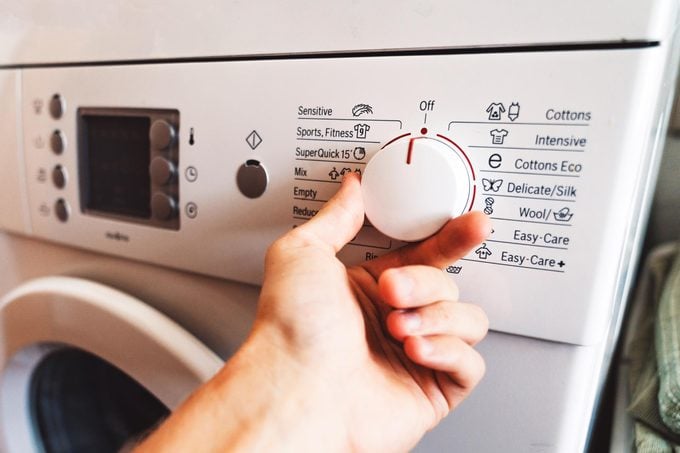
If your care label suggests a cool setting, follow the directions—cold water will always be a safe choice. If you want to sanitize your pillows, set the machine to the express cycle using hot water—research has found that lower water temps do not kill dust mites. To be extra cautious about potential residue left from previous wash cycles, you may also add a double rinse cycle.
Step 7: Dry
Transfer the pillows and three tennis or dryer balls to the dryer—the balls will help prevent the feathers from clumping and keep your pillows fluffy. Use a low-heat or air-dry setting, and make sure the pillows are completely dry before removing. Lingering dampness can lead to the growth of mold or mildew and cause funky odors.
How to wash foam pillows
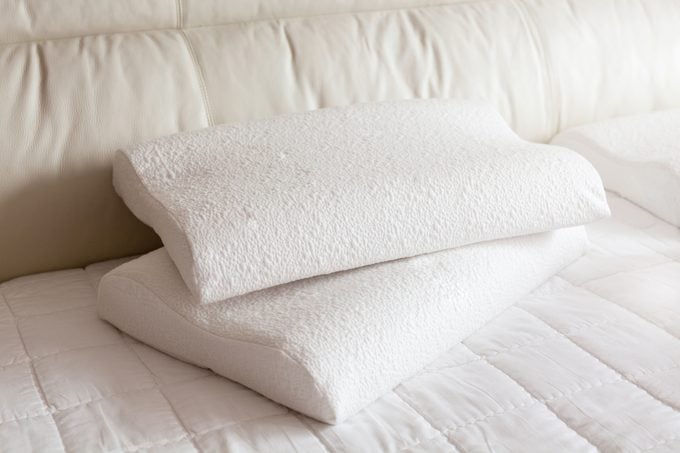
Step away from the washer and dryer! If you have foam pillows, you should simply dust them using a vacuum hose and spot clean them with a damp cloth. While most pillows are durable enough to withstand machine-washing and drying, foam pillows can be torn apart from the motions of the washer and dryer. Not only that, but machine-drying your foam pillow can greatly reduce its lifespan. Here’s how to hand-wash your foam pillow.
Supplies you’ll need
- Handheld vacuum
- Laundry detergent
- Water
- Cloth
- Dry towel
- Drying rack
Step 1: Remove and wash the pillowcase
Remove the pillowcase and/or protector and clean them according to their care label instructions.
Step 2: Vacuum and spot clean
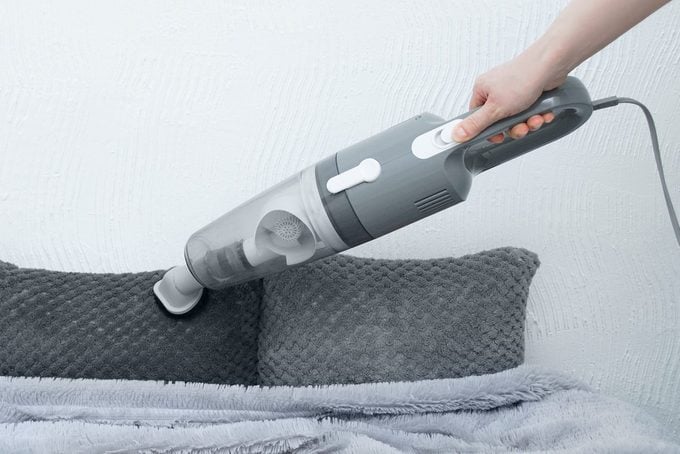
Use a handheld vacuum to pull off any lint or hairs. Then, dampen a clean cloth with water and a light amount of laundry detergent. Lightly rub the area that needs to be cleaned, making sure to press into the foam gently to penetrate the stain.
Step 3: Air-dry
It is imperative that you do not dry foam pillows in the dryer. Doing so could cause serious damage to your pillow. Instead, firmly press a dry towel to the treated area until it is as dry as possible. Then let the pillow sit in an uncovered and well-ventilated area on top of a drying rack until it’s completely dry to prevent mold from forming.
How often should you wash your pillows?
This depends on how often your pillow is used, how it’s protected and what it’s made of, Richardson says. Down pillows should be washed most often because they are the easiest for dirt and pathogens to penetrate. He washes his roughly four times a year. Foam is less penetrable, so it needs to be washed less frequently.
A pillow protector, which goes over the pillow and under a pillowcase, can decrease how often you need to clean a pillow by as much as 50%, Richardson says. These protective covers can be washed separately from the pillow. If you are regularly using and washing pillowcases and/or pillow protectors, you probably only need to wash the pillows themselves a few times a year. Spot cleaning more often can also help—keep in mind that when dirt and stains sit untreated for too long, they can shorten the lifespan of your pillow.
How can you freshen and fluff pillows between washes?
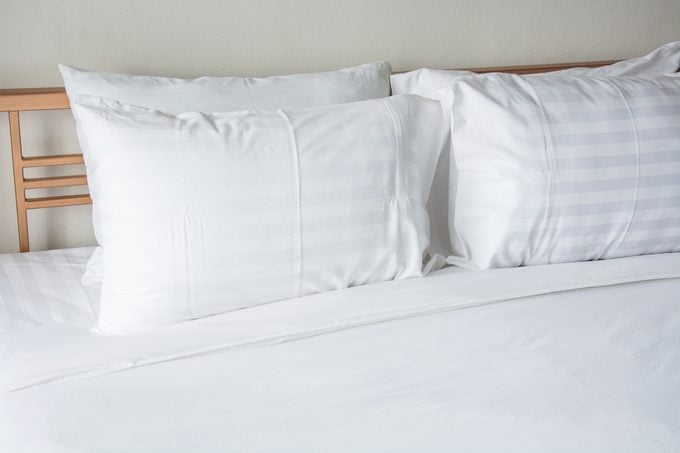
Washing pillows too often will wear them down more quickly, so if you want to keep your pillows around as long as possible while avoiding funky smells or illness-causing bacteria, you can use one of these two expert tricks.
- Use steam. Depending on the kind of pillow, you can use a steamer to kill pathogens. Be sure to check the care label first to make sure the steam, moisture and high temperature won’t do any damage (foam pillows, for instance, should never be steamed).
- Use vodka. To freshen up pillows without washing, fill a spray bottle with 100% vodka and spritz away. “Vodka is naturally antibacterial and dries odorless and colorless,” says Richardson. Spray the pillow and let it air-dry for an instant refresher. Note: Do not try this with any other alcoholic spirit.
When should you replace pillows?
When pillows lose their shape and fluffing doesn’t help, it’s time to get new ones. You can use this simple test: Fold the pillow in half. If it doesn’t bounce back to its original shape, you should replace it. You should also replace your pillows if any odor of mold or mildew is detected, Romine says.
Why trust us
At Reader’s Digest, we’re committed to producing high-quality content by writers with expertise and experience in their field, in consultation with relevant, qualified experts. For this piece, Maryn Liles tapped her experience as a longtime home and lifestyle writer. Then fabric-care and stain-removal expert Mary Marlowe Leverette gave it a rigorous review to ensure that all information is accurate and offers the best possible advice to readers. For this piece, we relied on reputable primary sources, including cleaning and health experts and reputable organizations. We verified all facts and data and backed them with credible sourcing, and we will revisit them over time to ensure they remain accurate and up to date. Read more about our team, our contributors and our editorial policies.
Additional reporting by Emily DiNuzzo.
Sources:
- Patric Richardson, host of The Laundry Guy on HGTV and Discovery+; interview, Jan. 14, 2024
- Kim Romine, fabric-care scientist at Procter & Gamble; email interview, January 2024
- Journal of Allergy and Clinical Immunology: “The role of water temperature and laundry procedures in reducing house dust mite populations and allergen content of bedding”
- American Thoracic Society: “Hotter Is Better for Removing Allergens in Laundry”

